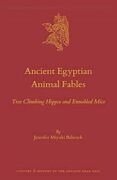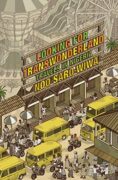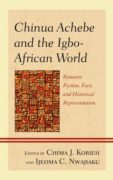Ancient Egyptian Animal Fables. Tree Climbing Hippos and Ennobled Mice (Brill, 2022), Jennifer Miyuki Babcock | A Review by Caroline Janssen
Introduction
A humble corpus of seventy-nine limestone flakes – ostraca – and four papyri lies at the basis of this book, a study of what Jennifer Miyuki Babcock understands to be visual representations of Ancient Egyptian animal fables. The author is a professor of Art History and Archaeology in New York, and specializes in the visual arts and narratives of Ancient Egypt, an interesting combination of fields, as the book demonstrates.
As for the corpus, as a writing material, papyrus was expensive and ostraca were cheap; the latter were used for a variety of purposes. Some were ‘textual’ – letters, inventories, receipts, work journals, …- while others were ‘figurative’ and contained drawings and sketches. Many of the ostraca were ex-votos, offerings made to deities to fulfill a vow, some may have been created for educational purposes or perhaps even out of boredom, as the author suggests. A small but interesting group depicts animals acting like people – wearing clothes, playing board games, banqueting, playing music, … – and these are the focus of this investigation. The most popular animals, for this purpose, are cats, mice, canines and caprids, but there are also birds, hippopotami and lions. Jennifer Miyuki Babcock chose to exclude most pictures with primates (with the exception of the motif of the baboon and the cat), because, as she argues, their activities could be the result of animal training; they usually appear in the company of people, not in anthropomorphic animal settings like the others.
Animals play a big role in Egyptian culture, religion and daily life. In representations, they are symbols of danger, strength, power, etc. In the hieroglyphic script animal-shaped signs can carry both literal and metaphorical meanings. On paintings, they appear in real-life conditions, crying out in pain, galopping, … and even their odor can be expressed by using symbols. But the ostraca are a group apart, as the animals here engage in human behavior. This is what animals in fables do. However, linking them to specific stories is not self-evident. The original drawings are not accompanied by explanatory texts and most drawings are not backed up by a recorded story. Jennifer Miyuki Babcock leaves no stone unturned to overcome this problem.
Let the reader be warned (but not deterred): this book is a reworked dissertation, which is still palpable, and it is not an easy read. It is based on original source materials that are hard to interpret. Before one can enter the world of tree climbing hippos and ennobled mice, one is deeply immersed in academic debates. What a reader not too familiar with Ancient Egyptian history might miss, at times, is a concise historical framework before these debates start, something I would have added because this book is of interest, not only for Egyptologists, but also for other people interested in fables and story-telling in other parts of the world or other temporal settings. There are a few flaws in the register which could have been avoided – e.g., the entries hippopotami, hippopotamus and hippotamus (sic!), hippotamus and crow but no crow as an entry, … – but on the whole this is a good work. In terms of methodology, the author is a guide, who presents complex theories in an accessible way and uses them eclectically. In the course of the book we find reflections on terminology and definitions; when different interpretations of materials have been suggested pros and cons are duly weighed, conclusions are drawn after consideration, the author shares her doubts and provides tentative explanations, it is up to the reader to agree or disagree. The author argues that in order to analyze the pictures one has to contextualize them and this becomes the key to their interpretation.
The book has six chapters, each of which opens up a new perspective:
- Introduction to the Materials
- Artists and Audience: Deir el-Medina and Its Inhabitants
- Understanding Ancient Egyptian Aesthetic Value
- Constructing Visual Narratives in Ancient Egypt
- Animal Fables and Their Purpose
- Contextualising the Egyptian Imagination: Concluding Thoughts
There is an Appendix of 84 pages, with colour photos of the papyri and ostraca, a few drawings, detailed descriptions and references. Not only is this catalogue fun to browse through, it also allows the readers to see the evidence with their own eyes. This catalogue is a most valuable instrument as the materials are not easily available otherwise. Beside all the rest, this book tells us a story of archaeological evidence that was dispersed over so many museums and private collections that studying them, today, requires an odyssey. As a result of historical power relations, many small artefacts have left Egypt, and are now in the US, UK, Germany, France, Italy, Belgium, Switzerland, Sweden, … The whereabouts of some of the materials cannot be traced anymore, in which case a modern drawing is all that remains. Writing this book required a lot of patience and dedication, even on a material level.
Missing: the archaeological context
Sadly, an utterly relevant context was lost in modern times. The ostraca and the papyri had once belonged to the vestiges of an ancient civilization, like the remnants of temples, houses, streets, tombs, skeletons, plant and animal remains. It seems that ostraca of different kinds were found in various contexts, such as the ‘Great Pit’, houses, tombs, streets, … but no one took care to note which one came from where so that we cannot know whether those with anthropomorphized animals came from a specific context, as a group or in groups, or were found in different settings. It is believed that all of them came from Deir el-Medina, the ‘Valley of the Artisans’, near Luxor, which can be ascertained for many of these, but not for all, and that is as far as one can get. The animal drawings can hence not be linked, by their archaeological context, to domestic, funerary or religious contexts, let alone to specific owners, their houses, graves, or other possessions, contexts that could potentially have contributed to their interpretability. Had they not been robbed of this context, because of 19th century looting and substandard excavation reports, all of these vestiges could have told their story in unison. The damage done is irreversible.
Deir el-Medina and its artisans
As for the makers of the ostraca, Deir el-Medina was not a run-off-the-mill village, as the author explains. Its artisans were the ones who excavated and decorated the royal tombs in the Valley of the Kings and that of the Queens. They were highly skilled and exceptional workers who also decorated tombs in their own village, with delightful scenes from every-day life. They were visually literate and educated people. Although the concept of art in contemporary European and American context has undergone a semantic shift – it now conjures up a world of individual expression, something almost transcendental, as the author explains – Jennifer Miyuki Babcock defends the position to call the products of Egyptian ‘craftmanship’ art. Artistic quality was something that was highly sought after and no one can doubt the artistic skills of the painters of Deir el-Medina.
Motifs
While in search of their meaning, the author notes that the anthropomorphized drawings on the ostraca reflect elite themes and that there are recurrent motifs. One of these, that of the cat and the vulture, can be successfully connected to the myth of the “Distant Goddess”: in this story the god Thoth appears in the shape of a baboon, while the goddess Tefnut has assumed the form of a cat. The former tries to convince the latter to return to Egypt by telling her a story of a cat and a vulture. Depictions of a baboon and a cat, or of a cat and a vulture (or other birds), are thus identified as depictions of fables. The author tentatively connects the story-telling and the ostraca to celebrations during festivals for the Distant Goddess. She points out that although materials from Deir el-Medina have been found in Amarna, no such ostraca were found in the city of Akhenaten (Akhnaton), an absence that she links to the pharao’s religious reforms. The fact that the connection with the Distant Goddess myth can be ascertained, means that other motifs which include anthropomorphized animals in story-like settings, are most probably also connected to animal fables. Some depictions are very specific, such as the hippopotamus sitting in a fruit tree with a crow climbing a ladder, or a hippopotamus and a crow sitting on opposite sides of a balance. These images raise so many questions that it would be easy to convert them into story lines (how did the hippo end up in the fruit tree? why does the crow not fly but use a ladder? is he crippled and if so, whose fault was that? …). Corroborating evidence that these are indeed animal fables, not just funny pictures, is that there seems to be ‘a stock of characters and motifs’ which, as the author states, include:
- Elite Animals and Offering Scenes
- Chariot Riding
- Religious Scenes
- Agricultural and Food Production Scenes
- Animal Musicians
- the Distant Goddess and the Cat/Vulture Fable
- the Boy, the Cat and the Mouse
- the Hippopotamus and the Crow
- Unclear/Miscellaneous
Narration
The reconstruction of narratives based on sequences of images found on the papyri turns out to be a challenge, since the materials do not seem to have been organized in a linear way. In ‘Constructing visual narratives in Ancient Egypt’ the reader is introduced into the conceptual world and theories of narratology and their application to visual materials. The author argues that we should look beyond the modern bias, that narratives should be presented in a linear sequence. To investigate how stories are presented in the visual arts of Ancient Egypt, she looks into paintings in tombs which depict the road to afterlife. She incorporates the idea of Assmann, that myths are organized around ‘nuclei’ (larger themes) which could be combined into ‘narrative constellations’ in oral story-telling, and wonders whether the ostraca were ‘icons’ that could be arranged and rearranged, during performances. Tentatively, she points out that in the 18th century, in what is now the Democratic Republic of Congo, lukasa memory boards were used by story-tellers (boards with beads, shells and metal) as a mnemonic device. Could the ostraca have had a similar function? The world of the Ancient Egyptian story-tellers is another lost dimension, but the author, as said, leaves no stone unturned to find relevant contexts and ideas which help us imagine how the texts might have functioned.
Interpreting the social implications of the fables is another topic that is covered, and here too we see how the author gains information from contextualizing the materials. Several ostraca reverse the roles of preys and predators, e.g., they depict mice who are being served by cats. Interpreting such scenes is not unambiguous and the author shows us a range of possibilities. Is role reversal a sign of rebellion against the existing social hierarchy? Not necessarily so, according to Jennifer Miyuki Babcock. She argues that the population of Deir el-Medina had more direct ways to express their dissatisfaction if needed; as evidence she adduces the fact that the first recorded strike ever was a sit-in near the mortuary temple of Ramasses II. She also denies that the pictures with the human-like animals are satirical or blasphemous representations of religious ceremonies. She points out that in the Book of the Dead, mice are presented as divine; the priest is a jackal. Blurred boundaries between humans and animals are omnipresent in Egyptian religion. It is by comparison with other materials from Egypt (Prophecies of Neferty, Admonitions of an Egyptian Sage) and near-by regions such as Mesopotamia and Greece that she finds reason to believe that stories about social upheaval and chaos could well end in a restoration and celebration of existing power relations.
Imagination
The ostraca and papyri are silent witnesses of the history of human imagination. To unmute them the author contextualized what she saw. The patience and dedication that was put into this scholarly work has paid off; she has definitely shed light on the interpretability of these images and there is a lot to discover in this book. Although the study is focused on a better understanding of Ancient Egyptian materials, it is relevant for a variety of readers. It shows us a road that lies ahead, one that runs in two directions. For one thing, it reminds us that research in fields like Assyriology and Egyptology that helps us interpret drawings on limestone flakes also urges us to deconstruct the myth of the Greek miracle, of Aesops who appear out of the blue. ‘Unmuted histories’ that are the results of archaeological, anthropological and textual explorations, are starting to shed light on the relations between cultures and on captivating literary networks. Historical power relations have created disbalanced views of the past. Contemporary research tells us to revise such views. Meanwhile, creativity and imagination keep doing their work, because subconsciously, when reflecting on this need to bring more balance in the reconstruction of the fragmented history of humanity, the image of the heavy hippo and the light-weighted crow, who struggled to find a balance, comes to my mind. An ancient fable whose original context is clouded is trying to rewrite itself in a contemporary setting, which is what fables do.
For all these reasons I recommend this book.
Caroline Janssen (Ghent University)




